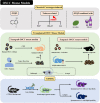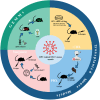Mouse Tumor-Bearing Models as Preclinical Study Platforms for Oral Squamous Cell Carcinoma
- PMID: 32158692
- PMCID: PMC7052016
- DOI: 10.3389/fonc.2020.00212
Mouse Tumor-Bearing Models as Preclinical Study Platforms for Oral Squamous Cell Carcinoma
Abstract
Preclinical animal models of oral squamous cell carcinoma (OSCC) have been extensively studied in recent years. Investigating the pathogenesis and potential therapeutic strategies of OSCC is required to further progress in this field, and a suitable research animal model that reflects the intricacies of cancer biology is crucial. Of the animal models established for the study of cancers, mouse tumor-bearing models are among the most popular and widely deployed for their high fertility, low cost, and molecular and physiological similarity to humans, as well as the ease of rearing experimental mice. Currently, the different methods of establishing OSCC mouse models can be divided into three categories: chemical carcinogen-induced, transplanted and genetically engineered mouse models. Each of these methods has unique advantages and limitations, and the appropriate application of these techniques in OSCC research deserves our attention. Therefore, this review comprehensively investigates and summarizes the tumorigenesis mechanisms, characteristics, establishment methods, and current applications of OSCC mouse models in published papers. The objective of this review is to provide foundations and considerations for choosing suitable model establishment methods to study the relevant pathogenesis, early diagnosis, and clinical treatment of OSCC.
Keywords: HPV; OSCC; chemical carcinogen-induced; genetically engineered models; mouse models; syngeneic; transplanted; xenograft.
Copyright © 2020 Li, Dong, Yang, Song, Mou and Ni.
Figures







Similar articles
-
Mouse Models for Immune Checkpoint Blockade Therapeutic Research in Oral Cancer.Int J Mol Sci. 2022 Aug 16;23(16):9195. doi: 10.3390/ijms23169195. Int J Mol Sci. 2022. PMID: 36012461 Free PMC article. Review.
-
Mouse Models for Head and Neck Squamous Cell Carcinoma.J Dent Res. 2024 Jun;103(6):585-595. doi: 10.1177/00220345241240997. Epub 2024 May 9. J Dent Res. 2024. PMID: 38722077 Review.
-
Current mouse models of oral squamous cell carcinoma: Genetic and chemically induced models.Oral Oncol. 2017 Oct;73:16-20. doi: 10.1016/j.oraloncology.2017.07.028. Oral Oncol. 2017. PMID: 28939069 Review.
-
Establishment of a xenograft model to explore the mechanism of bone destruction by human oral cancers and its application to analysis of role of RANKL.J Oral Pathol Med. 2016 May;45(5):356-64. doi: 10.1111/jop.12376. Epub 2015 Oct 13. J Oral Pathol Med. 2016. PMID: 26859422
-
Establishing of mouse oral carcinoma cell lines derived from transgenic mice and their use as syngeneic tumorigenesis models.BMC Cancer. 2019 Mar 29;19(1):281. doi: 10.1186/s12885-019-5486-7. BMC Cancer. 2019. PMID: 30922255 Free PMC article.
Cited by
-
Oncolytic activity of naturally attenuated herpes-simplex virus HF10 against an immunocompetent model of oral carcinoma.Mol Ther Oncolytics. 2020 Dec 19;20:220-227. doi: 10.1016/j.omto.2020.12.007. eCollection 2021 Mar 26. Mol Ther Oncolytics. 2020. PMID: 33665360 Free PMC article.
-
Tissue Mechanics and Hedgehog Signaling Crosstalk as a Key Epithelial-Stromal Interplay in Cancer Development.Adv Sci (Weinh). 2024 Sep;11(35):e2400063. doi: 10.1002/advs.202400063. Epub 2024 Jul 8. Adv Sci (Weinh). 2024. PMID: 38976559 Free PMC article.
-
Multifunctional photodynamic/photothermal nano-agents for the treatment of oral leukoplakia.J Nanobiotechnology. 2022 Mar 4;20(1):106. doi: 10.1186/s12951-022-01310-2. J Nanobiotechnology. 2022. PMID: 35246146 Free PMC article.
-
A method for scoring 4-nitroquinoline 1-oxide-induced murine esophageal squamous neoplasia.Vet Pathol. 2023 May;60(3):384-393. doi: 10.1177/03009858231151381. Epub 2023 Feb 1. Vet Pathol. 2023. PMID: 36726342 Free PMC article.
-
Genetically engineered mouse models of head and neck cancers.Oncogene. 2023 Aug;42(35):2593-2609. doi: 10.1038/s41388-023-02783-7. Epub 2023 Jul 20. Oncogene. 2023. PMID: 37474617 Free PMC article. Review.
References
Publication types
LinkOut - more resources
Full Text Sources

